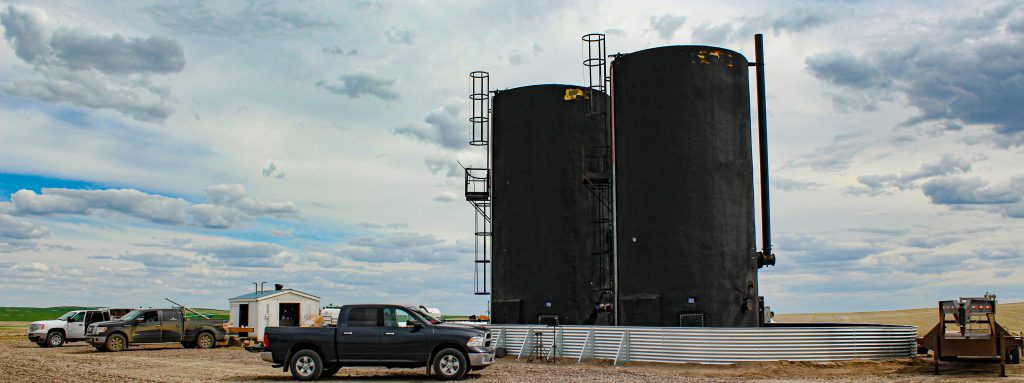
Tanks Vapors are a major sources of emissions
During oil and gas production, pressurized formation liquids (oil and water) are often stored in liquid storage tanks. When the pressurized liquid solution enters the atmospheric storage tank, gases are released from the solution. Often, these gases are emitted from the tank’s vent, which is used to equalize pressure inside the tank.

Photo showing typical Cold Heavy Oil Production (CHOPS) Site Setup with 1000bbl tanks
Tank emissions are challenging to measure and, in many cases, go unreported. The Alberta Energy Regulator (AER) has identified some methodologies for estimating these emissions (Manual 15 – Estimating Methane Emissions (December 2020)), and the emission estimates are required for routine venting measurement as regulated under AER Directive 060.
Estimates from the AER show that roughly 19% of all oil and gas emissions come from Venting, including tank venting1.
In fact, the GreenPath Alberta Fugitive and Vented Emissions Inventory Study from 2016 2, verified that tank venting is substantial.
The survey focused on six geographical areas as defined by the AER’s administrative regions: Grande Prairie, Drayton Valley, Red Deer, Medicine Hat, Midnapore and Bonnyville. For the other five regions, the study encompassed the collection of equipment inventories and the qualitative detection of methane leaks and vents via optical gas imaging (OGI) at approximately 240 unique facilities with more than 300 oil and gas wells. For Bonnyville, the data did not include equipment inventories. Instead, they focused on qualitatively detecting methane leaks and vents via OGI at 102 Cold Heavy Oil Production with Sand (CHOPS) locations. From the 102 locations, it was reported that 136 tanks showed some Venting.
Needless to say, tank venting is common and is substantial.
How to eliminate emissions from tank vents?
In many cases, vent gases from production can be conserved and put into pipelines. However, there are several cases where these gases are not economical to capture and conserve. For example, in CHOPs production, where sites are isolated, the gases aren’t generated until the production formation solution is stored and possibly heated in a storage tank. These gases have poor gas quality and typically can’t be repurposed in a firetube or on-site pump engine, so they must be mitigated another way.
In some instances, venting can be captured using a vapour recovery unit (VRU). VRU’s can often capture all of the tank emissions on-site, but for VRU’s to be effective, they need to be tied into a pipeline. Capturing gases without a place to send them doesn’t eliminate the problem.
When conservation is not an option, producers can eliminate the methane emission by combusting it. Different options work for this application, however, many producers are leaning towards enclosed combustors. Enclosed combustors operate with a very high burn efficiency and are safely located within 10 meters of the tanks.
Over recent years, design innovations have pushed enclosed combustor technology to be much more affordable than traditional setups, and producers recognize the benefits.

Photo showing E-Series Enclosed Combustor combusting tanks vapours at a site near Lloydminster, SK
EnviroVault offers the E-Series Enclosed Combustors, for example, that provide high-performance combustion (99.9% combustion efficiency) in a compact, affordable design and can achieve maximum airflow to the combustion chamber while simultaneously cooling the outer shell. They are also designed with several layers of backflash protection so operators can know their equipment will operate safely in any condition.
Tank venting emissions are a serious concern. As a result, oil and gas producers will be putting together their plans to conserve, eliminate or reduce these emissions. With options like the E-Series Enclosed Combustor, producers find a more affordable solution to manage these emissions.
References
- Video. June 2010. Technical Summary of Directive 060 Methane Regulations. Posted on YouTube by AER. Retrieved from URL.
https://www.youtube.com/watch?v=lCh5nUmrklc
- Author – GreenPath Energy Ltd. 2016. GreenPath Alberta Fugitive and Vented Emissions Inventory Study. Retrieved from URL.
https://static.aer.ca/prd/documents/GreenPathAER%20Survey-Methane.pdf
Share This:





 CDN NEWS |
CDN NEWS |  US NEWS
US NEWS 





























